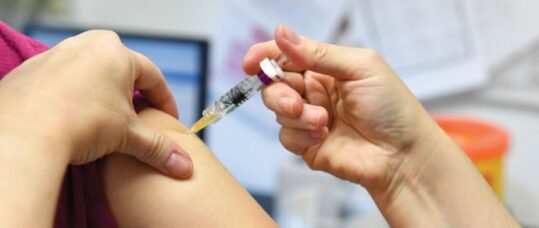Mythbuster – ‘I’m not getting the flu jab – it gives you the flu!’

The myth
The seasonal influenza vaccination does not protect against the flu virus and can cause flu symptoms.
The reality
The seasonal flu vaccination is not live and therefore cannot cause any flu symptoms. It is, however, the only protection against flu.
Vaccines generally come in two different forms: attenuated and inactivated. Attenuated vaccines are ‘live’ and contain weakened strains of the viruses they are protecting from. Examples include the measles, mumps and rubella (MMR), and the more recent flu nasal spray vaccination for children. However, the adult seasonal flu vaccination is an inactivated vaccine. Inactivated vaccines are made from viruses or bacteria that have been killed and, therefore, cannot spread any form of the disease or virus they protect from. Yet this common myth continues to be believed by many patients and healthcare workers alike.
Related Article: Diagnosis Connect service will link people to advice from charities
There are three possible reasons for this. Firstly, once any vaccination is administered, the body should start to develop an immune response. In some people, this can present as mild ‘cold-like’ symptoms that will only last for a couple of days and can be easily treated with paracetamol. It is important to remember that these symptoms are a sign that the body is responding to the vaccine and are different to flu symptoms, which can make the body ill very quickly with a fever, body aches and rigor. In most cases flu will leave a person unable to get out of bed for days and susceptible to other complications. Flu can be fatal and still accounts for 8,000 deaths in England every year.1 The more recent H1N1 strain is significantly harmful for young people and to mother and baby in pregnancy.2,3 In contrast to the seriousness of the virus, the most common reaction to a flu vaccination is a red swollen area at the injection site, which will disappear within days.4
Secondly, the seasonal flu vaccination is administered between September and March, which is the same time of year as the virus is in circulation. The vaccine can take up to 14 days to become effective once received, meaning it is possible to contract the flu during this period. It is therefore important to receive the flu vaccination at the start of the programme.
Thirdly, every year the World Health Organization recommends which virus strains vaccine manufacturers should include. The vaccine can take up to eight months to produce. Occasionally, a different strain of influenza will emerge that cannot be added to the vaccine in time. This can make the vaccine less effective against that strain. However, when the vaccine is well-matched to the circulating strain it is 50-70% effective.5
It is vital that the myths and common misconceptions about the flu vaccine are debunked and the magnitude of the flu virus is recognised. Patients in ‘at risk’ groups – as defined by the Department of Health – and all healthcare workers can receive a free vaccination every year either from their GP or employer. For others the vaccine
can be received at most local pharmacies for a small fee.
For those who have suffered flu, the vaccination is an essential element of ‘winter wellness’ to ensure patients, staff, visitors and family are protected. For those who have been fortunate enough not to have had the flu, it is important to remember that people can also be a carrier of flu and yet be asymptomatic themselves. This can result in the person unknowingly spreading the virus to susceptible people around them.
The timing and severity of flu is unpredictable. Sadly, a healthy diet and stringent handwashing cannot prevent a person from contracting this airborne virus.6 The flu vaccination alone is the only thing that can prevent it – so patients and healthcare workers alike have a responsibility to protect themselves and those around them as early as possible from this serious and deadly disease.
Tracy Lees is nurse manager and flu lead with the occupational health and wellbeing service for Sandwell & West Birmingham Hospitals
Related Article: CVD prevention must be national health priority, says report
References
1 Public Health England. Public Health England and the NHS prepare for unpredictable flu season. London;PHE:2014
2 Public Health England. Influenza vaccine effectiveness in adults and children in primary care in the UK: provisional end-of-season results 2015-16. London;PHE:2016
3 Donaldson L, Rutter P, Ellis B et al. Pandemic flu mortality in England. British Medical Journal 2009;339:b5213
Related Article: Postnatal contraception advice reduces the risk of back-to-back pregnancies
4 Centres for Disease Control. Influenza Prevention and Control Recommendations Adverse Events After Receipt of TIV. CDC;Atlanta:2011
5 Andrews N, McMenamin J, Durnall H, et al. Effectiveness of trivalent seasonal influenza vaccine in preventing laboratory-confirmed influenza in primary care in the United Kingdom: 2012/13 end of season results. Euro Surveill 2014;19:5-13
6 Burch T. Motivators and barriers for influenza vaccine uptake among healthcare workers: results of an online staff survey, East Midlands Seasonal Influenza Debrief. Nottingham;2012

See how our symptom tool can help you make better sense of patient presentations
Click here to search a symptom


Tracy Lees gives tips for advising patients who do not want to get the flu jab due to a belief that it causes the flu.



